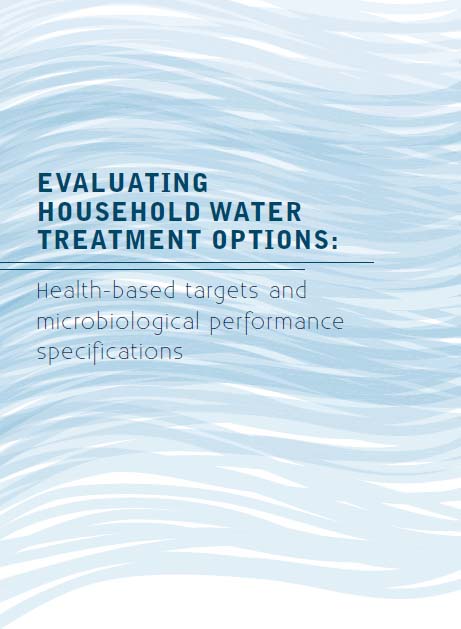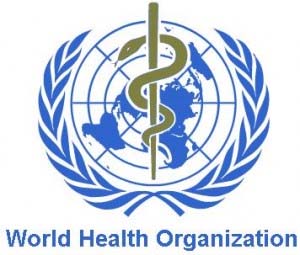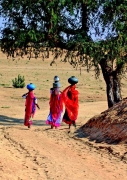World Health Organisation (WHO)
Evaluating household water treatment options
Posted on 17 Jul, 2011 02:11 PM This document by the World Health Organisation, for the first time, sets forth global criteria to evaluate whether a household water treatment option reduces waterborne pathogens sufficiently to protect health. Through use of a risk-based framework and by emphasizing the philosophy of incremental improvement, it is intended to provide implementers and policy-makers with an evidence-based and pragmatic approach to select options suited to local conditions.
This document by the World Health Organisation, for the first time, sets forth global criteria to evaluate whether a household water treatment option reduces waterborne pathogens sufficiently to protect health. Through use of a risk-based framework and by emphasizing the philosophy of incremental improvement, it is intended to provide implementers and policy-makers with an evidence-based and pragmatic approach to select options suited to local conditions.
Household water treatment interventions may play an important role in protecting public health where existing water sources, including those delivered via a piped network or other improved sources, are untreated, are not treated properly or become contaminated during distribution or storage. Household water treatment applications are a range of technologies, devices or methods employed for the purposes of treating water at the household level or at the point of use in other settings, such as schools, health-care facilities and other community locations. Point-of-use water treatment is another term used for household water treatment.
Guidelines for drinking water quality - Fourth edition by World Health Organisation (2011)
Posted on 09 Jul, 2011 10:41 AM This integrates the third edition, which was published in 2004, with both the first addendum to the third edition, published in 2006, and the second addendum to the third edition, published in 2008. It supersedes previous editions of the Guidelines and previous International Standards.
This integrates the third edition, which was published in 2004, with both the first addendum to the third edition, published in 2006, and the second addendum to the third edition, published in 2008. It supersedes previous editions of the Guidelines and previous International Standards.
This edition of the Guidelines further develops concepts, approaches and information introduced in previous editions, including the comprehensive preventive risk management approach for ensuring drinking-water quality.
Water safety plan: A manual for pilot study areas of Hyderabad
Posted on 20 Apr, 2011 02:03 AMThe most effective means of consistently ensuring the safety of drinking water supply is through the use of a comprehensive risk assessment and management approach, that encompasses all steps in water supply from catchment to consumer. Such approaches are called Water Safety Plans (WSPs).
The aim of a WSP is to organize and systematize records of management practices applied to drinking water and to ensure workability of such practices to organized drinking water supply.
Application of Composite Correction Program for improvement in efficiency of water treatment plants - A WHO paper
Posted on 20 Apr, 2011 12:41 AMThe goal of safe and affordable drinking water and sanitation has not yet been achieved. The current practices of water purification are inadequate to produce secured water supply. Maintaining health protection at water supply systems has become more challenging with resistance of some pathogens to disinfection using chlorination and an increase in the immuno-compromised population (e.g., people with HIV, organ transplant patients, the elderly).
In this context, it has become essential to develop various tools such as Composite Correction Programme (CCP) and Water Safety Plans (WSP) to improve water purification and distribution systems, to achieve the goal of providing safe drinking water.
Water Supply and Sanitation: India Assessment – A WHO-UNICEF sponsored study by the Planning Commission of India
Posted on 19 Nov, 2010 08:52 PMThis country-level report on the assessment of drinking water supply and sanitation in India is the result of a collaborative exercise between the Planning Commission of India, the World Health Organization (WHO), and the
Resources on water quality, public health and water safety from the World Water Day - UN Water website
Posted on 02 Jul, 2010 01:24 AM The UN-Water website's World Water Day 2010 section, provides access to a range of informative, educational and advocacy material on water.
The UN-Water website's World Water Day 2010 section, provides access to a range of informative, educational and advocacy material on water.
The documents and publications section includes a range of documents related to water quality, drinking water quality and public health, and water safety planning and management including the safe use of wastewater for agriculture and aquaculture.
Progress on sanitation and drinking water - A report by WHO and UNICEF (2010)
Posted on 01 Jul, 2010 01:45 PM This report by WHO and UNICEF, describes the global status and trends with respect to the use of safe drinking water and basic sanitation, and global progress made towards the Millennium Development Goals (MDGs) in the context of drinking water and sanitation targets. The findings reveal some striking disparities with respect to:
This report by WHO and UNICEF, describes the global status and trends with respect to the use of safe drinking water and basic sanitation, and global progress made towards the Millennium Development Goals (MDGs) in the context of drinking water and sanitation targets. The findings reveal some striking disparities with respect to:
- the gap between progress in providing access to drinking water versus sanitation
- the divide between urban and rural populations in terms of the services
- the differences in the way different regions are performing
- disparities between different socio-economic strata in the society
- gendered differences in the burden experienced in accessing and collection of drinking water
Progress on drinking water and sanitation - Special focus on sanitation
Posted on 17 Sep, 2009 01:50 PM This report found on the World Health Organisation site has been brought out by the WHO/UNICEF Joint Monitoring Programme for Water Supply and Sanitation, that tracks the progress on target 10 of the Millennium Development Goals (MDGs), which is "To halve, by 2015, the proportion of people without sustainable access to safe drinking water and sanitation".
2008 being the International Year of Sanitation, the report highlights the importance of sanitation, as being the crucial stepping stone to health , which offers:
World Health Organisation provides fact sheets of water-related diseases, their causes and measures for prevention
Posted on 20 May, 2009 01:16 PMThis site by the World Health Organisation (WHO) provides access to water and sanitation related disease fact sheets, which provide information on the disease and how it affects people, the causes, distribution, scope of the problem and th
Safe piped water: managing microbial water quality in piped distribution systems - A WHO publication
Posted on 12 May, 2009 05:47 PMMicroorganisms occur in piped distributions from source water, through contamination during distributions and because of growth. Different organisms may cause a range of adverse health effects. Effective management varies with the organisms and their origin.